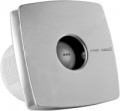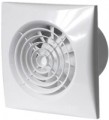Type of bearing
The type of bearing installed in the fan.
The bearing is a part that secures the rotating part of the fan to the stationary part and reduces friction between these parts. By type, it can be as follows:
— Plain bearing. The action of such bearings is based on the friction between two conjugated, that is, directly pressed one to the other over the entire area, surfaces. However, these surfaces are in contact with each other relatively weakly — between them is a layer of lubricant that reduces friction. In addition, to reduce resistance, rubbing parts are usually carefully polished and made of anti-friction materials. The main advantage of plain bearings is the simplicity of design and the resulting low cost. However, such parts are less durable than ball bearings, and they create more noise.
— Ball bearing. The principle of operation of a ball bearing is that a set of balls is placed between its movable and stationary parts, which roll inside during movement. Compared to plain bearings, such bearings last much longer, and they create less noise during operation. On the other hand, fans with similar equipment are noticeably more expensive.
Air flow (extraction)
This parameter describes the amount of air that the fan can pass through itself per hour when operating in extraction mode (see "Type"). It is one of the key characteristics of any extractor fan — it characterizes the overall performance and suitability of the unit for a particular room.
When choosing a fan for
maximum performance, two main indicators must be taken into account — the volume of the room and the air flow rate. The volume can be found by multiplying the area of the room by the height of the ceilings: for example, for a room of 12 m² in a residential apartment with standard ceilings of 2.5 m, this figure will be 12x2.5=30 m³. The air flow rate describes how many times per hour the air in an enclosed space must be completely replaced for ventilation to be sufficiently effective. This multiplicity is different for different types of premises: in particular, for the kitchen, it is 6-8, for the bathroom — 8-10, etc. More detailed values be found in specialized sources, in particular, sanitary standards. And the minimum required fan performance is calculated by multiplying the air volume by the air exchange rate. For example, if we have a bathroom with an area of 4 m² with the same ceiling of 2.5 m, then the volume of air in it will be 4x2=10 m³; Considering that the minimum air exchange rate for bathrooms is 7, for this room we need a fan with a capacity of at least 70 m³/h.
Rotational speed
The nominal fan speed during operation.
The rotational speed is one of the factors affecting the performance and, consequently, the overall efficiency of the fan. At the same time, this factor is far from being the only one. A lot also depends on the design of the blades, their number, the diameter of the impeller, etc. Therefore, fans with the same speed can differ significantly in capabilities, and you should pay attention primarily to performance.
At the same time, the rotation speed still has a certain practical significance. On the one hand, faster fans produce more noise; this drawback can be compensated to a certain extent by design tricks, but they, in turn, noticeably affect the price. On the other hand, to ensure the desired level of performance, lower-speed fans must either have impellers of a larger diameter (which accordingly affects the dimensions, and in most cases, the installation size) or, again, use design tweaks that affect the price.
Power consumption
The power consumed by the fan during normal operation.
This parameter primarily affects the power consumption of the device and the load on the power grid created during its operation. However, the latter is usually not critical, since the power of most modern fans is low. Also, the more powerful the device, the higher its performance(see above). However, there is no unambiguous dependence here — much is determined by how effective the design is. Therefore, models with the same performance can differ markedly in power consumption.
When choosing between two similar models with different power consumption, you should proceed with how often and for how long you plan to turn on the fan. If regular work is expected for a long time — for example, to ventilate the kitchen while cooking — you should pay attention to a less powerful model. It may cost more, but the price difference can quickly pay off in energy savings. If the fan turns on occasionally (for example, when installed in the bathroom of a residential apartment), you can not pay much attention to the power consumption.
Noise level
The noise level reproduced by the fan in normal operation.
The
lower the noise level, the more comfortable the use of the fan will be, the better it is suitable for rooms in which it is desirable to keep silence. In addition, there are certain regulations written in sanitary standards (for example, for residential premises during the day, a constant noise level of up to 40 dB is considered acceptable, and at night — up to 30 dB).
When choosing according to specific values recorded in the characteristics, it should be taken into account that the decibel used to measure the noise level is not a linear quantity: for example, an increase in sound power by 2 times corresponds to an increase of 3 dB, 10 times — by 10 dB, 100 times — by 20 dB. Therefore, to assess the noise level, it is easiest to refer to comparative tables, where the correspondence of specific values in decibels to various real sound sources is recorded. In most modern fans, noise is between 20 and 60 dB, here is the simplest table for this range:
20 – 25 dB — a weak audible sound, comparable to a whisper at a distance of 1 – 2 m;
25 – 30 dB — intelligible whisper at a short distance, ticking of a wall clock;
35 dB — muffled conversation;
40 – 45 dB — normal human speech;
50 – 55 dB — talking in raised tones, noise in the office;
60 dB — loud conversation at a distance of several metres.
Note that patter
...ns over 50 dB are rare; usually, these are “industrial” class units with a 400 V power supply and a large mounting diameter (see above), not intended for residential premises.Protection level
The level of protection of the fan housing (more precisely, sensitive parts located in the housing) from dust and moisture, measured by the IP standard. This standard assumes marking in the form of two numbers after the letters IP — for example, IP54. In this case, the first digit describes the level of protection against dust and other objects, and the second — from moisture.
In terms of resistance to the penetration of foreign objects in fans, the following values \u200b\u200bcan be found:
2 — protection against objects larger than 12.5 mm (enough to protect against adult fingers);
3 — from objects larger than 2.5 mm;
4 — from objects more than 1 mm (not every wire can get inside);
5 — full protection against objects; a small amount of dust may have entered the unit without any noticeable effect on performance.
In terms of water protection, options can be as follows:
4 — resistance to water splashes from any direction;
5 — resistance to water jets from any direction;
7 — the ability to endure short-term immersion in water to a depth of 1 m without consequences.
There are also higher rates of water protection. However, it does not make sense to provide them to fans. The mentioned "4" and "5" are quite sufficient for installation in bathrooms, showers and most other places where there is
...a possibility of moisture getting on the units, higher levels of protection complicate and increase the cost of the design, and there is very little practical need for them.
In some models, instead of one digit (most often the first one), there may be the letter X. This does not mean the absence of appropriate protection — it most often exists, and sometimes its degree can be quite high; we are only talking about the fact that official testing according to the IP standard was not carried out. For example, a fan marked IPX4 can be closed even from a thin wire, but if it passed official tests only for moisture resistance, the manufacturer has the right to indicate only one digit.
It is also worth noting that the complete absence of IP marking does not mean a lack of protection. However, if resistance to dust and moisture is crucial for you, you should still choose among models where this feature is officially claimed by the manufacturer.Perimeter suction
A suction system that draws in air through a series of holes around the perimeter of the air intake. This design provides high suction efficiency and, at the same time, allows you to apply advanced design solutions to the device. Perimeter suction is characteristic mainly of models of the upper price range.
Cover height
The size of the decorative fan cover in height.
For details on the features of such panels in different types of fans, see "Cover diameter". The same size is indicated in cases where the panels are in the shape of a square or rectangle (see "Cover shape").
Cover width
The size of the decorative fan cover in width.
For details on the features of such panels in different types of fans, see "Cover diameter". The same size is indicated in cases where the panels are in the shape of a square or rectangle (see "Cover shape").

